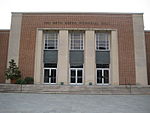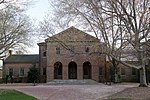Muscarelle Museum of Art
1983 establishments in VirginiaArt museums and galleries in VirginiaArt museums established in 1983College of William & Mary buildingsMuseums in Williamsburg, Virginia ... and 4 more
United States art museum and gallery stubsUniversity museums in VirginiaVirginia museum stubsVirginia university stubs

The Muscarelle Museum of Art is a university museum affiliated with the College of William & Mary in Williamsburg, Virginia. While the Museum only dates to 1983, the university art collection has been in existence since its first gift – a portrait of the physicist Robert Boyle – in 1732. Most early gifts to William & Mary relate to its history or the history of the Commonwealth of Virginia. Gifts of portraiture were the foundation of the early collection and include many First Families of Virginia (FFV) including sitters from the Page, Bolling and Randolph families.
Excerpt from the Wikipedia article Muscarelle Museum of Art (License: CC BY-SA 3.0, Authors, Images).Muscarelle Museum of Art
Phi Beta Kappa Circle, Williamsburg
Geographical coordinates (GPS) Address External links Nearby Places Show on map
Geographical coordinates (GPS)
| Latitude | Longitude |
|---|---|
| N 37.2679526 ° | E -76.7158878 ° |
Address
Muscarelle Museum of Art
Phi Beta Kappa Circle
23185 Williamsburg
Virginia, United States
Open on Google Maps










